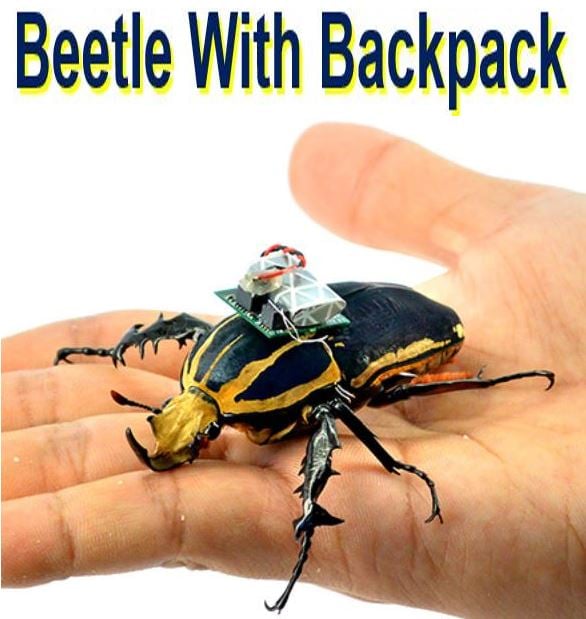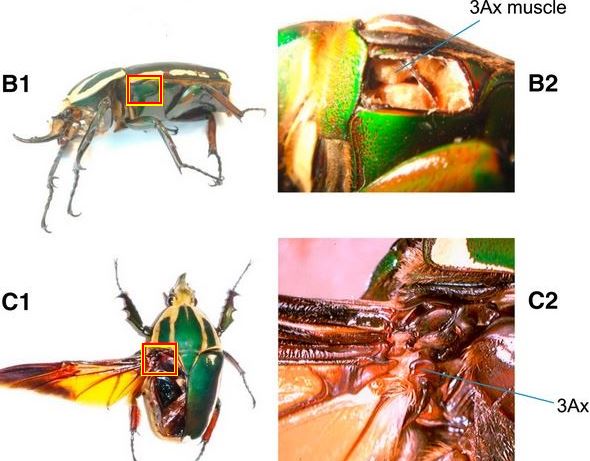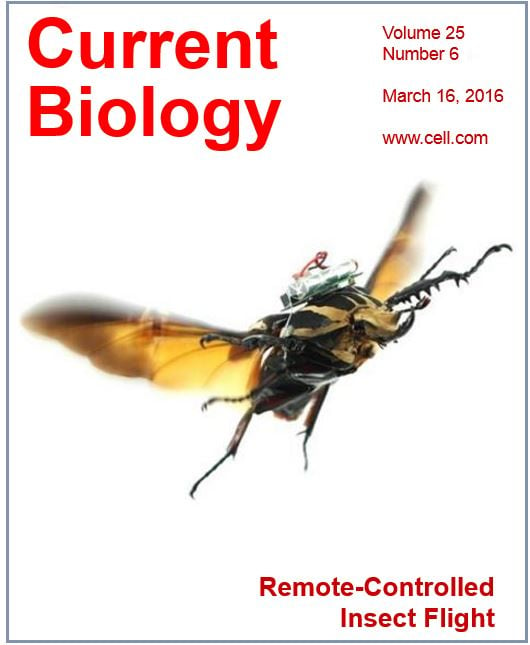Scientists have developed a living cyborg, a beetle with an electronic backpack and built-in WiFi receiver, that can be remotely controlled with the minimal of human intervention, says a team of scientists from Nanyang Technological University in Singapore. People only intervene to alter its route, the insect does everything else on its own.
This ‘living machine’ – a giant flower beetle – is fitted with a device that converts radio signals received remotely into a wide range of actions in the insect.
Scientists wrote in the academic journal Current Biology (citation below) that signals were transmitted to the beetle’s high-tech backpack every millisecond (thousandth of a second), directing it to take off, turn right or left, or even hover in mid-flight.
 The advantage of using a beetle instead of a drone is that you do not need to steer it around obstacles – it does that on its own. (Image: ntu.edu.sg)
The advantage of using a beetle instead of a drone is that you do not need to steer it around obstacles – it does that on its own. (Image: ntu.edu.sg)
The untethered beetle flew inside a closed room with eight 3-D motion capture cameras to record movement data.
Continuous human control not necessary
Unlike your typical remote-controlled man-made drones, there is no need for non-stop human control, because the beetle can stay in the air and maintain flight stability on its own. Human intervention is only required when you want the beetle to change direction.
The rest of the journey is taken care of by the beetle – it weaves its way around objects and crawls into confined spaces, up to 100 metres.
The study, carried out by researchers from Nanyang Technological University (NTU) and the University of California, Berkeley, was also picked up as one of Current Biology’s best research discoveries, making the cover of the month’s publication.
 Stimulator device mounted on a live beetle. The device consisted of a custom printed circuit board (PCB) on which a microcontroller, battery with a pair of thin wires, and connector were mounted. Four silver wires were tightly inserted into the headers, which were mounted on the PCB and electrically connected to the outputs of the micro-processing unit. The other terminals of the wires were implanted into the left and right wing-folding muscles and the mesothorax center hemolymph. (Image: cell.com)
Stimulator device mounted on a live beetle. The device consisted of a custom printed circuit board (PCB) on which a microcontroller, battery with a pair of thin wires, and connector were mounted. Four silver wires were tightly inserted into the headers, which were mounted on the PCB and electrically connected to the outputs of the micro-processing unit. The other terminals of the wires were implanted into the left and right wing-folding muscles and the mesothorax center hemolymph. (Image: cell.com)
An alternative to remote-controlled drones
Project leader, Assistant Professor Hirotaka Sato, from the NTU School of Mechanical and Aerospace Engineering, said:
“By sending a signal to the beetle, we are able to simply change its direction of movement and the beetle will manage the rest.”
“This technology could prove to be an improved alternative to remote-controlled drones as it could go into areas which are not accessible before. For example, it could be used in search-and-rescue missions as it could go into small nooks and crevices in a collapsed building to locate injured survivors.”
Regarding the team’s long-term vision, Michel Maharbiz, associate professor at UC Berkeley’s Department of Electrical Engineering and Computer Sciences said:
“Our long term vision is to show that we can remotely induce an insect to fly, control its turns when required, and then stop it when the insect reached a set location – all done repeatedly and reliably.”
 (B1 & B2) Lateral view of a beetle after dissection of a cuticle (B2), showing the flight muscle of 3Ax muscle. Top view of a beetle after the left elytra was removed and the hind wing was unfolded (B1), exposing the left wing base indicated by the red square. (C1 & C2) Close-up view showing the 3rd axillary sclerite (3Ax) (C2) that was internally and directly connected to the 3Ax muscle and externally connected to the wing base via a tendon. (Image: cell.com)
(B1 & B2) Lateral view of a beetle after dissection of a cuticle (B2), showing the flight muscle of 3Ax muscle. Top view of a beetle after the left elytra was removed and the hind wing was unfolded (B1), exposing the left wing base indicated by the red square. (C1 & C2) Close-up view showing the 3rd axillary sclerite (3Ax) (C2) that was internally and directly connected to the 3Ax muscle and externally connected to the wing base via a tendon. (Image: cell.com)
The giant flower beetle (Mecynorrhina torquata) averages approximately 8 grams in weight and 6 cms in length. Despite its size, it is able to lift relatively heavy payloads, including a thermal sensor and a small microphone, which are vital for search-and-rescue missions.
Cheap microelectronics
The backpack can be built for less than $10. The researchers say the electronics are very easy to build, consisting mostly of off-the-shelf components.
The system is operated by a microprocessor, which apart from combining thousands of tiny transistors on a 1-cm2 chip, also comes with a built-in wireless receiver.
The researchers used harmless organic beeswax to strap the microchip onto the beetle, which makes it easy to remove.
Six electrodes from the microprocessor are connected into the optic lobes and flight muscles of the insect. The wireless signals sent influence the beetle to take off, change direction and even hover seemingly motionless in mid-flight.
 The study made the front cover of Current Biology.
The study made the front cover of Current Biology.
The whole setup is powered by a 3.9 volt micro lithium battery with enough juice to last a day. However, the scientists say that eventually it will operate without a battery.
Prof. Sato said:
“In the future, the overall rig may not even use batteries. It could be powered from sustainable sources such as energy scavenged from ambient radio waves.”
The high-tech, detachable backpack does not harm the beetle, which goes on to live its normal five-to-six month lifespan.
Specific muscle controls steering
Between the beetle’s wings is the coleopteran muscle, which for two centuries scientists thought controlled just the folding of the wings.
However, in this study, the researchers discovered that this muscle also controls steering and turning ability.
Prof. Sato said:
“Since the 1800s, the beetle’s coleopteran muscle was thought to function solely in wing folding. Our wireless system allows us to record neuro-muscular movements in natural, free flight and by doing so, we found out that this muscle is also used for steering and turning.”
This new finding highlights the potential for further studies to improve the precision of the beetle’s remote-controlled turns, the authors said.
This project was supported by NTU, the US National Science Foundation, and the Agency for Science.
Citation: “Deciphering the Role of a Coleopteran Steering Muscle via Free Flight Stimulation,” Hirotaka Sato, Tat Thang Vo Doan, Svetoslav Kolev, Ngoc Anh Huynh, Michel M. Maharbiz, Pieter Abbeel, Chao Zhang, Travis L. Massey, Joshua van Kleef, Kazuo Ikeda. Current Biology Volume 25 , Issue 6 , 798 – 803. 16 March, 2016. DOI: org/10.1016/j.cub.2015.01.051.
Video – Turning a beetle into a ‘cyborg’
Scientists have implanted electrodes into this beetle’s muscles, which allows them to ‘drive’ the bug. Applications range from spy work to rescue to inspection.
